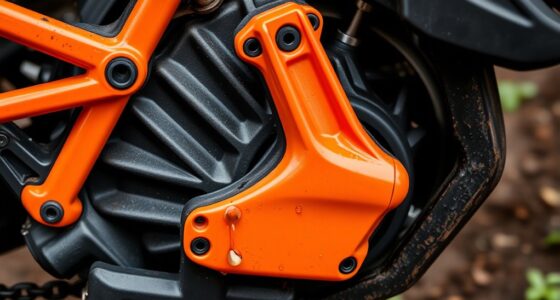Steering dampers really come in handy when you notice wobbling, instability, or sudden steering jerks, especially when driving fast or on rough terrains. They help control unpredictable movements, absorb vibrations, and improve handling, making your ride smoother and more stable. You’ll benefit most if your steering feels twitchy or loose at high speeds or off-road. Want to know more about how and when to use them effectively? Keep exploring further.
Key Takeaways
- They help reduce steering wobble and vibrations on rough terrain or at high speeds.
- They improve vehicle stability during off-road driving or when carrying heavy loads.
- They minimize twitchy or unpredictable steering responses, especially on twisty or windy roads.
- They are beneficial when experiencing loose steering, wandering, or excessive oscillations.
- Regular inspection and proper adjustment ensure damping effectiveness and prevent steering issues.
Understanding the Role of Steering Dampers
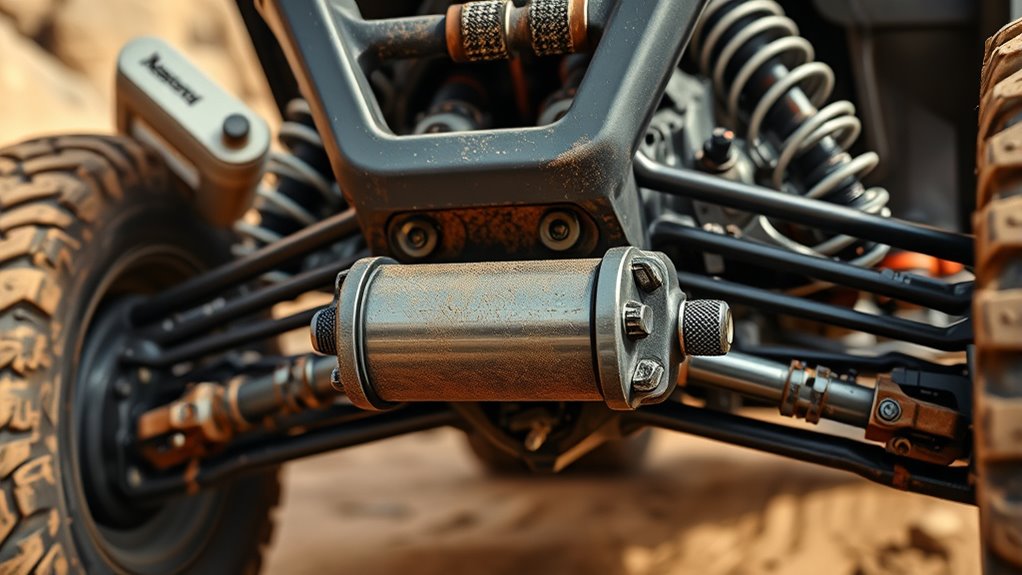
Steering dampers play a crucial role in maintaining vehicle stability by controlling unwanted movement in the steering system. When you drive over rough or uneven surfaces, your steering can become jerky or oscillate, making control difficult. The damper absorbs and reduces these vibrations, preventing excessive steering wheel movement. It acts as a shock absorber for the steering system, smoothing out sudden shocks and oscillations caused by road irregularities or high-speed driving. Without a damper, your steering might feel twitchy or unstable, especially at higher speeds. This component works silently in the background, ensuring you maintain better control and a comfortable ride. Proper installation of steering dampers is essential for optimal performance and safety. Understanding its role helps you appreciate how steering dampers contribute to safer, more predictable driving experiences.
How Steering Dampers Improve Handling and Stability
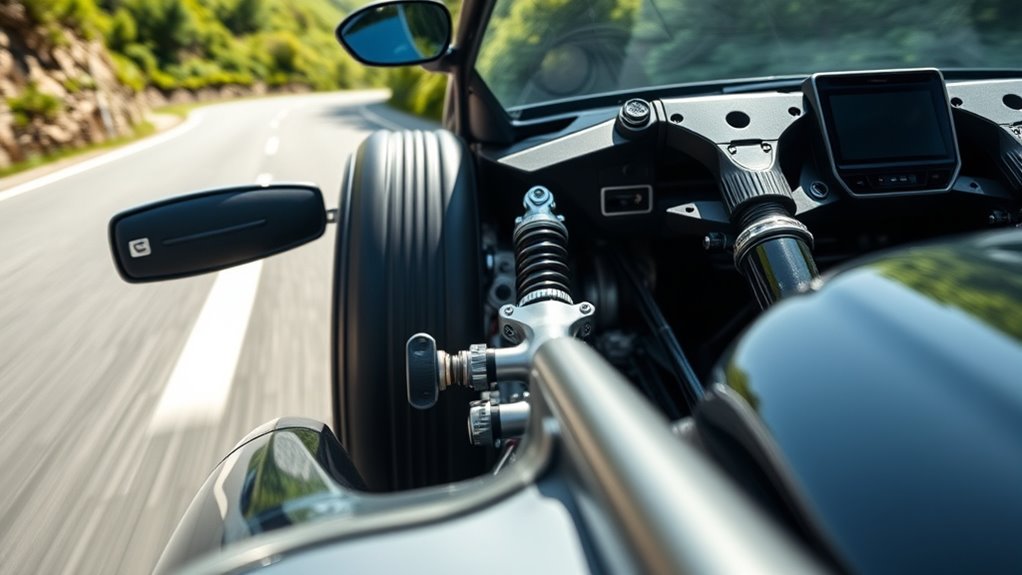
By reducing unwanted steering movements, dampers considerably enhance a vehicle’s handling and stability. They keep the front end more controlled, especially at high speeds or on rough roads. When your steering feels twitchy or unpredictable, a damper dampens sudden jolts and oscillations, allowing for smoother, more precise steering. This stability makes it easier to maintain your lane and respond accurately to steering inputs. Dampers also help prevent the wheel from wobbling or bouncing, which can cause fatigue and reduce confidence behind the wheel. Proper installation and maintenance are crucial to ensure optimal performance and safety. Overall, they improve your vehicle’s responsiveness, giving you a more confident and comfortable driving experience. Whether you’re on uneven terrain or racing, steering dampers provide the extra control needed to handle challenging conditions effectively.
Signs That Indicate You Might Need a Steering Damper
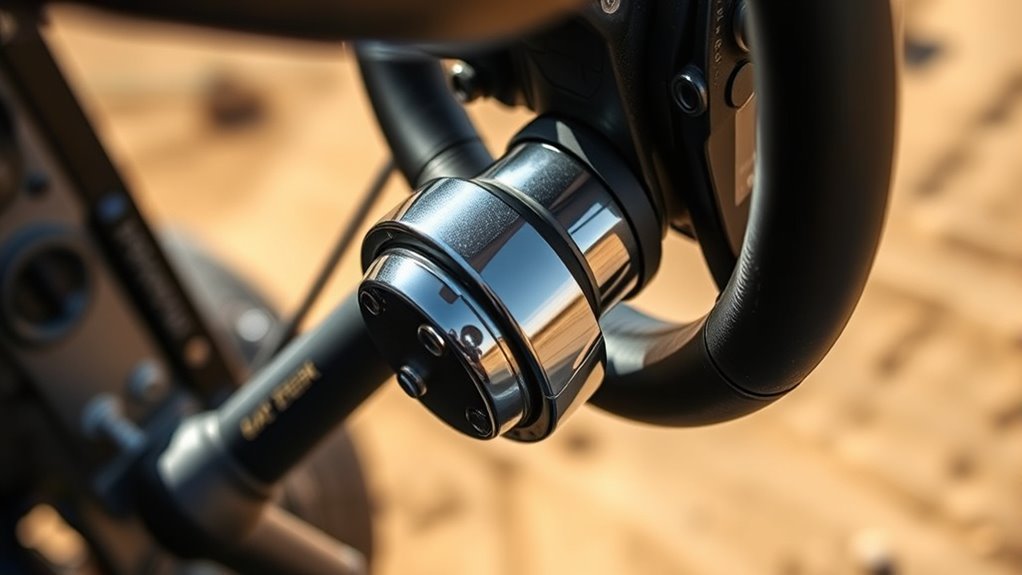
Have you noticed your steering becoming more unpredictable or twitchy than usual? If so, it could be a sign you need a steering damper. You might feel excessive vibrations through the handlebars or a sudden, sharp wobble when hitting bumps or rough patches. Drift or wandering steering—where your bike doesn’t stay straight without constant correction—also indicates instability. Additionally, if your front end feels loose or you experience a nervous “shaking” at higher speeds, a damper might help stabilize the ride. These symptoms suggest your steering components are working harder to maintain control, and a damper can absorb some of those shocks. Recognizing these signs early can prevent further wear and improve your riding confidence and safety. Proper maintenance and timely upgrades can help extend the lifespan of your steering system and reduce the need for additional components.
Situations Where Steering Dampers Make a Notable Difference

Situations where a steering damper truly shines often involve riding conditions that challenge your bike’s stability. If you’re riding at high speeds on twisty roads, a damper helps reduce sudden, unpredictable steering movements caused by gusts of wind or uneven pavement. When you’re tackling rough, rocky terrain or off-road trails, it can prevent your front end from wobbling or feeling loose, providing better control. In windy conditions, a steering damper minimizes the impact of crosswinds that might push your front wheel off course. It’s also beneficial if you frequently ride with a passenger or carry heavy loads, which can make your steering feel heavier or more unstable. Additionally, high-quality projectors can enhance your riding environment by providing clear, detailed visuals for navigation or entertainment during breaks. In these situations, a steering damper helps you stay confident and in control.
Common Vehicles and Applications for Steering Dampers
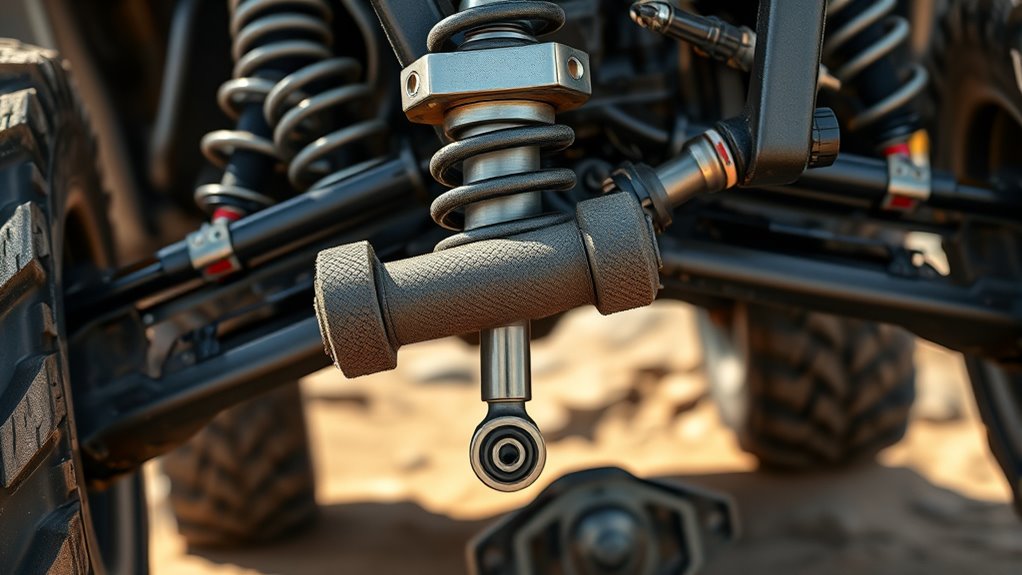
Steering dampers are commonly found on a variety of vehicles where enhanced stability and control are essential. Off-road trucks and SUVs often use them to manage rough terrain and prevent steering wobble. Motorcycle riders, especially those on touring or adventure bikes, rely on dampers to reduce handlebar shake at high speeds and improve maneuverability. Heavy-duty construction equipment, like bulldozers and cranes, utilize steering dampers to maintain precise movements under heavy loads. Military vehicles, such as armored personnel carriers, also employ dampers to ensure stability during rapid maneuvers. Additionally, some performance cars and rally vehicles use steering dampers to control steering response during aggressive driving. In all these applications, dampers help mitigate steering kickback, improve precision, and enhance safety in demanding conditions.
Limitations of Steering Dampers in Improving Ride Quality
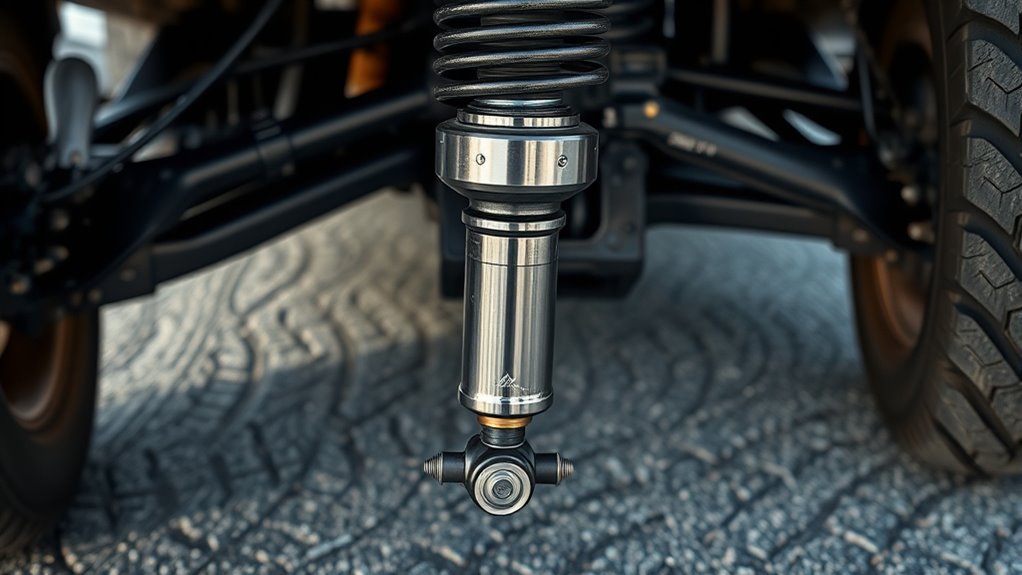
While steering dampers can enhance stability and control, they have limitations when it comes to improving overall ride quality. They primarily target steering input vibrations and sudden movements, but they don’t address issues like suspension comfort or road surface irregularities. If your goal is a smoother ride, dampers won’t compensate for poorly tuned suspension or bumpy roads. Overly stiff dampers can even make the ride harsher, transmitting more vibrations rather than absorbing them. Additionally, dampers don’t reduce body roll or improve cornering comfort directly. Their main function is to stabilize steering, not to enhance ride softness or reduce chassis vibrations. Relying solely on a steering damper won’t transform a rough ride into a plush one.
Installing and Choosing the Right Steering Damper
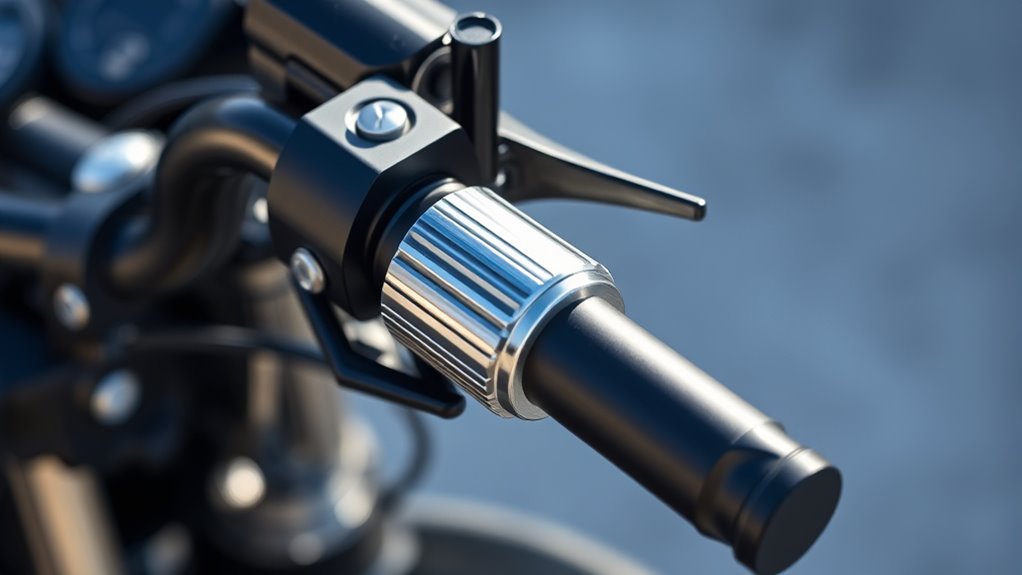
Choosing the right steering damper starts with proper mounting to guarantee stability and safety. You’ll also want to select a damper that matches your vehicle’s compatibility features for peak performance. Finally, adjusting the damping settings allows you to fine-tune handling based on your riding style and terrain. Incorporating insights into vehicle dynamics can further enhance your understanding of how a damper influences overall control.
Proper Mounting Techniques
Selecting the right mounting location and hardware is essential for guaranteeing your steering damper functions effectively and lasts longer. You want to position the damper where it can absorb vibrations without interfering with steering movement or other components. Typically, mounting it between a sturdy part of the frame and the steering linkage or suspension arm works best. Use high-quality bolts and brackets designed for your vehicle’s specifications to prevent loosening or damage. Ensure the damper is aligned properly, with minimal stress on the mounting points, to avoid premature wear. Keep it clear of moving parts and heat sources. Check the tightness regularly, especially after off-road use, to maintain ideal performance. Proper mounting guarantees your damper provides consistent steering control and durability. Additionally, consider the installation process to ensure all components are secure and aligned correctly for optimal performance.
Selecting Compatibility Features
To guarantee your steering damper works effectively, you need to focus on selecting compatibility features that match your vehicle’s specifications. First, check your vehicle’s make, model, and year to find dampers designed for your setup. Consider the mounting style; some dampers require specific brackets or mounting points, so ensure these align with your vehicle’s frame. Pay attention to the stroke length and diameter of the damper, as these affect performance and fit. Also, verify the damper’s mounting orientation and clearance to avoid interference with other components. Compatibility extends beyond size—ensure the damper’s load capacity matches your driving conditions, whether for off-road ruggedness or street stability. Properly matching these features guarantees ideal function and durability. Recognizing the importance of self-awareness can help in understanding how your vehicle responds to different damper settings, ensuring optimal handling and comfort.
Adjusting Damping Settings
Adjusting damping settings is essential for optimizing your steering damper’s performance to match your driving style and conditions. Start by understanding your typical terrain and handling preferences. Softer settings provide smoother steering on paved roads, while stiffer settings improve control on rough or off-road trails. Always test adjustments gradually, making small changes and noting their effects. Keep in mind:
- Fine-tune based on feedback from your handling experience
- Balance comfort and control for ideal driving experience
- Adjust damping to reduce unwanted steering oscillations
- Remember that different conditions may require different settings
When to Reconsider or Remove a Steering Damper
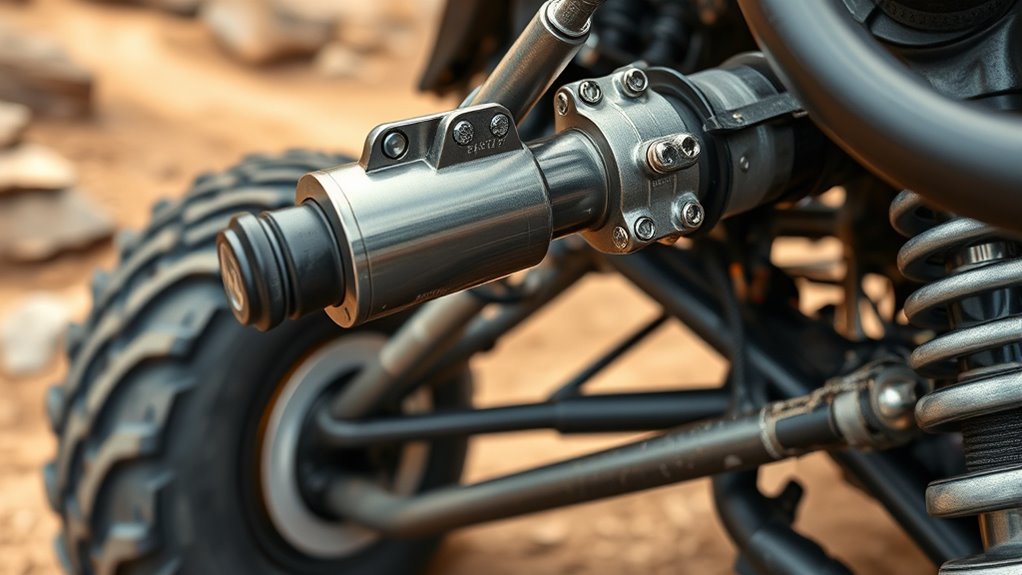
If your steering feels off or less responsive, it might be time to reconsider your damper. Signs like increased wobbling or poor handling suggest the damper isn’t working effectively. Removing or adjusting it could restore better control and improve your ride. Monitoring steering responsiveness can help identify when maintenance or adjustments are necessary.
Damper Ineffectiveness Signs
When a steering damper no longer functions effectively, you’ll notice specific signs that indicate it’s time to reconsider or remove it. You might feel that steering feels more unstable, especially on rough roads or at high speeds. You could also observe increased vibrations or wobbling, which the damper used to suppress. Additionally, if you experience inconsistent steering response or unusual noises, it’s a clear sign the damper isn’t doing its job. You should consider removing or replacing the damper if you notice: – Reduced control over steering movements – Excessive vibrations or wobbling – Unusual noises when turning or driving – Persistent steering instability despite adjustments. These signs suggest the damper has lost effectiveness and may be doing more harm than good.
Furthermore, product quality can influence the damper’s longevity and performance, so inspecting the component regularly helps determine if it’s still functioning properly.
Handling and Control Issues
Are handling and control becoming unpredictable on your vehicle? If your steering feels overly stiff, vague, or twitchy, it might be time to reconsider your steering damper. A damper designed for rough terrain can cause too much resistance on smooth roads, reducing your ability to respond quickly. If you notice increased steering effort or a loss of precision, the damper may be over-dampening your steering input. Similarly, if you experience wobbling or instability at higher speeds, removing or adjusting the damper could restore better control. Trust your instincts—if your steering feels inconsistent or less responsive than usual, it’s worth testing your vehicle without the damper or consulting a professional. Proper handling is essential for safety and confidence behind the wheel. Additionally, understanding handling and control issues can help you identify whether your suspension components or steering setup need adjustment or replacement.
Frequently Asked Questions
Can Steering Dampers Be Used on Electric Vehicles?
You might wonder if steering dampers work on electric vehicles. The answer is yes; they can be used if your EV has steering components that benefit from shock absorption. Dampers help stabilize steering, especially on rough roads or high speeds. However, since electric vehicles often have different suspension setups, it’s best to check compatibility with your specific model. Installing a damper could improve comfort and control in certain driving conditions.
Are There Specific Brands Known for the Best Steering Dampers?
Think of steering dampers as the unsung heroes of your vehicle’s smooth ride. When choosing the best brand, you’ll want to look at trusted names like Bilstein, Fox, and Koni. These brands have a reputation for durability and performance. You’ll find that investing in quality dampers is like adding a steady hand to your steering—making every drive safer and more comfortable.
How Often Should Steering Dampers Be Inspected or Replaced?
You should examine your steering damper at least every 10,000 miles or if you notice handling issues like looseness or vibration. Replace it if you see leaks, excessive wear, or if it no longer provides smooth steering. Regular checks help maintain safe handling, so don’t wait for problems to worsen. Staying proactive ensures your vehicle stays responsive and your driving remains safe and comfortable.
Do Steering Dampers Affect Fuel Efficiency?
You might think steering dampers impact fuel efficiency, but they actually don’t substantially affect it. Their main job is to stabilize your steering, especially on rough terrain or during high-speed driving. When they work properly, they improve handling and reduce steering effort, but they don’t influence your vehicle’s fuel consumption. So, if you’re concerned about saving gas, focus on tire pressure, aerodynamics, and driving habits instead.
Can Steering Dampers Be Customized for Off-Road or Racing Vehicles?
You can definitely customize steering dampers for off-road or racing vehicles. By choosing different damping rates, mounting styles, and sizes, you tailor the setup to your specific needs. Off-road dampers often require higher resistance for rough terrains, while racing dampers focus on quick response and stability at high speeds. Customizing allows you to optimize handling, control, and comfort, giving you an edge whether you’re tackling trails or race tracks.
Conclusion
Imagine your hands confidently guiding the wheel through twists and turns, the road ahead smooth and steady. Steering dampers can be your secret weapon against sudden jolts and wobbles, providing calm amid chaos. But remember, they’re not magic. Knowing when they truly help keeps your ride safe and comfortable. So, stay alert for signs, choose wisely, and enjoy the feeling of control as you carve through every mile with confidence.



